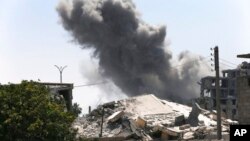The U.S.-led coalition in Syria and Iraq has ramped up its attack on the final remnants of Islamic State, increasing the number of strikes by more than 300 percent over the number of airstrikes in March.
The coalition Monday announced that it conducted 225 strikes again Islamic State (IS) forces in May, a 304 percent increase over the 74 strikes it carried out in March.
Military officials said the strike numbers reflect a refocus by U.S.-supported Syrian Democratic Forces (SDF) on the latest counter-IS assault in the Middle Euphrates River Valley. Dubbed Operation Roundup, the assault follows months of U.S. calls to its allies, the SDF and Turkey, to stop fighting each other in northern Syria and turn their efforts toward defeating IS.
In March, the majority of the predominantly Kurdish population of Afrin, in northwest Syria, evacuated under threat of attack from Turkish military forces and Turkish-backed opposition forces. Some Kurdish fighters in the SDF flocked to Afrin after a plea from locals to protect the city, which Turkey called a haven for terrorism against its nation.
U.S. officials have repeatedly said the fighting in northwestern Syria "distracts" from the counter-IS campaign and provides an opportunity for the group to begin reconstituting in some areas.
"The SDF paused offensive operations in response to the situation in Afrin. The coalition is providing airstrikes and shaping fires in support of the renewed SDF offensive," Pentagon spokesman Marine Major Adrian Rankine-Galloway told VOA.
Coalition estimates of remaining Islamic State fighters in Iraq and Syria dropped below 3,000 last year, but coalition spokesman Army Colonel Sean Ryan told VOA there are still plenty of fighters spread across the Middle Euphrates River Valley.
"I think there's more than what people are saying," Ryan said. "And they're in small pockets, for example, 40 of them can hide in a 200-square-kilometer area, and that is a lot of ground to cover."
It remains unclear when the coalition fight against Islamic State in Iraq and Syria, which is in its fourth year, will end.
Secretary of Defense Jim Mattis told reporters Monday at the Pentagon that it was "unanimous" among all countries in the counter-IS coalition that they should continue their fight until the destruction of the terror groups' geographic caliphate in Syria and Iraq is complete.
In a press briefing last week, Army Colonel Thomas Veale, another coalition spokesman, stressed the counter-IS fight was designed to attack not only the individual fighters, but also the group's capabilities.
"What we're concerned with, rather than numbers, is their ability to reform the connective tissues they had that will allow them to continue to plan, fund, inspire, train, recruit and continue to be a threat to the world," Veale said.









